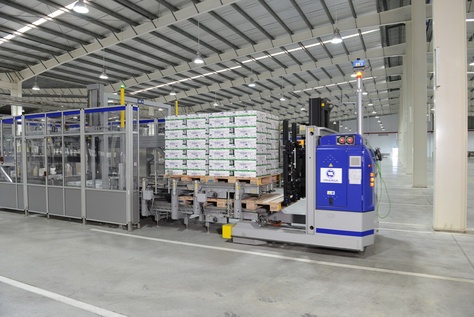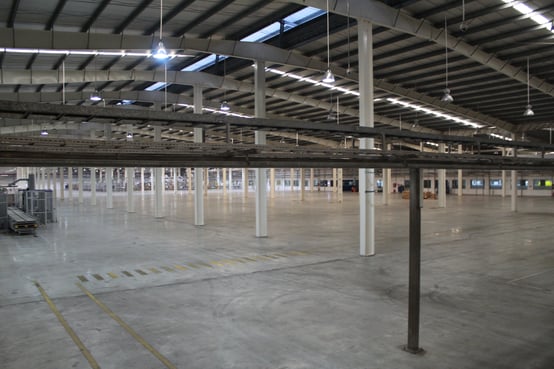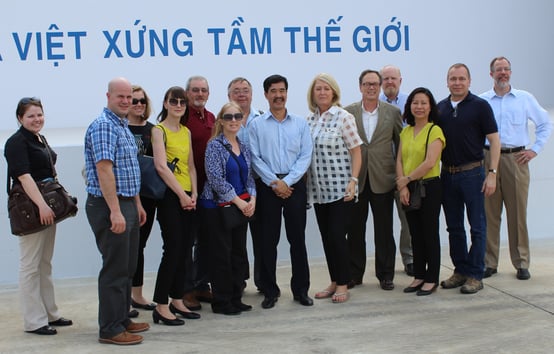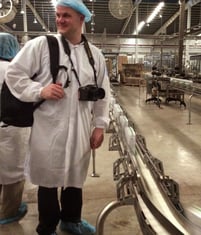-
Bigger Role for Robotics in U.S. Dairy Plants
By USDEC July 27, 2016- Tweet
For years, companies like Vietnam's Vinamilk have been ahead of the United States in robotic automation. But the gap may close.
On a tropically humid, 95-degree day in Vietnam, four U.S. dairy farmers, two dairy trade journalists and several U.S. Dairy Export Council staffers left their hotel in Saigon (Ho Chi Minh City) for a sweltering bus ride north.
Ten miles later, the bus stopped at a gleaming white Vinamilk processing plant in Binh Duong province. Inside, pallet-carrying "automated guided vehicles," commonly called robots, criss-crossed a massive warehouse with 17 floors of shelving. Without a single complaint, they tirelessly delivered electronically coded products exactly where a command control center told them them to.

Blue robot loads pallet at Vinamilk plant in Vietnam (Photo: SSI Schaefer)
One Pennsylvania dairy farmer avoided an international incident by nimbly stepping sideways a fraction-of-a-second before he experienced a man vs. machine collision. The machine did not deviate. It was on a mission.
In a country known for low labor costs -- the average factory worker makes less than $7 per day -- the company dominating the dairy industry increasingly relies on robotic automation.
“We invest in high technology in order to protect the quality of the product,” Nguyen Quoc Khánh, Vinamilk's executive director for R&D and production, told his U.S. visitors. "The more people who interrupt the system the more risk you have. Plus, the cost of labor is increasing year by year.”
Having modern dairy processing plants, equipped with robotics, is a selling point for dairy-exporting countries. For instance, Vietnam can point to the Vinamilk plant and say that its producers can compete with producers around the world in terms of production conditions. A senior executive from Vinamilk makes that claim in a recent article from VietNamNet Bridge concerning the likelihood that Vietnam will begin exporting dairy products to China.
The argument for more robots
Robotics can increase efficiencies, lower costs and make dairy processors more competitive in a competitive global marketplace. It can also free up time to devote to other important tasks. This has been happening for years on U.S. farms, many of which are installing robotic milking systems, as pointed out in this article from The New York Times.
Advocates argue they don't have to replace human workers. In fact, they can increase oppportunities that make it possible to hire more humans.
U.S. dairy plants are showing increased interest in robotics, but still lag behind Vietnam's Vinamilk and much of the world for a variety of reasons.
For example, automation for pre-packaged raw products can be tricky since food processing equipment, especially in U.S. grade "A" dairy plants, must meet hygienic design criteria for cleanability and inspectability. These criteria are defined in 3-A Sanitary Standards and Accepted Practices and used for evaluating equipment and process systems.
Video produced by SSI Schaefer showing its warehouse automation at Vinamilk.
The standards-developing organization, 3-A Sanitary Standards Inc., is close to publishing a new equipment standard for robot-based automation systems. For the first time, robotic manufacturers will have industry-consensus guidelines for manufacturing equipment intended for processing milk, dairy products, food ingredients, beverages and other edible materials.
That increased clarity could help speed U.S. adoption of automation.
U.S. plants 'falling behind'
Bob Rochelle, business development director at Nachi Robotic Systems, says during the past five years he has experienced a “large increase” in the number of U.S. dairy companies wanting a robotic expert, such as himself, to come out, visit and educate them about robotic-based automation systems.
In addition, there has been “a definite increase in the number of food processors visiting automation-specific trade shows,” Rochelle says.
At the International Cheese Technology Exposition, Rochelle recalls seeing one robot—a palletizer—on display in 2012. This year the number of robots on display had grown to five.
It would be good if the interest level were to increase even more, says Jana Crandall, marketing manager at Quest Industrial, the largest integrator of cheese-handling robotics in North America.
“Robotic automation is perfect for repetitive and difficult tasks, many of which are unsafe for humans to perform,” Crandall says. “These robotic systems help reduce work-related lost-time claims, reduce downtime and speed up the production process, allowing for a more efficient and effective plant. We design our robotic automation to fit into a compact area because many plants do not have the floor space for large systems. This allows the smaller plants to stay competitive as well.”
If adopted, robotics could give some U.S. dairy processors a competitive edge.
“Overall, the United States has fallen behind several other countries in the robot-to-human ratio, including China,” she says. “This means that our companies are dabbling in robotics, not owning it.”
Robots don't call in sick
“Robots are reliable, they won’t call in sick, and are maintainable,” Crandall says. “Plant and human resource managers are finding that it is hard to fill and keep filled those positions which are repetitive; robots can fill those labor shortages. Plant managers move their best people into more fulfilling positions where they can thrive as operators and maintenance technicians, at a higher wage. The company increases their production and efficiencies and the employees are compensated at a higher level due to the increase in production and sales,” she says.
In some industries, such as automotive, robotics are already well established.
Orders for industrial robots in North America rose from 8,200 in the first half of 1999 to 14,100 in the first half of 2014, according to the Robotics Industries Association. (See "The new hire: How a new generation of robots is transforming manufacturing" from PwC.)
Increasingly, orders are coming in from industries that aren't traditional users of robotics. In 2005, 3 percent of North American robot orders were from food and consumer goods companies; by 2014, that number had increased to 7 percent.
Robots are even making their way into to the fast-food industry, as demands for a higher minimum wage have prompted some chains to explore robotic options. In July, McDonald’s will open a restaurant in the Phoenix, Ariz., that is entirely run by robots.
While the automated McDonald’s in Phoenix could very well eliminate jobs, there are other instances where robotics can lead to job creation.

Robots make traveling around this massive Vinamilk warehouse more efficient.
“People see robotics as taking away jobs, but we have found for every one robot we integrate into a system, between five and eight jobs are created within the next three years,” Crandall says. “This causes continued exponential growth for the company."
The PwC report confirms Crandall's point about robotics generating jobs rather than eliminating them.
Heat and other challenges
Dairy processing plants are often warm, humid environments, which present challenges to the use of robotics.
The challenges to using robotics in warm, humid environments are great, acknowledges Eric Schweitzer, director of standards and certification at 3-A Sanitary Standards Inc. Those challenges are certainly operational, but of main concern is the sanitary design so that equipment is cleanable and inspectable, he says.
Schweitzer and other industry stakeholders have been working since 2011 to develop a new 3-A Sanitary Standard that will apply to the sanitary use of industrial robot systems in food processing where process equipment cleaning and sanitization is required. The standard will address robot and ancillary robotic system equipment, including the robot base, end of arm tooling, tool changers and robot dressing, but does not apply to robots associated with milking systems on dairy farms.
The new standard should be in place within the next few months.
When finalized, the standard will establish sanitary design criteria for robot manufacturers and allow them to develop the type of equipment that can successfully be used in food-processing facilities.
“We feel that the (new) standard will help fill the gap between the already existing standards and the new technology that robotics and automation brings to the table,” says Quest Industrial’s Jana Crandall.
Less human contact
Crandall points out that robots can make a positive contribution to sanitation in dairy-processing plants.
"Cheese and other dairy plants are able to lower their food infractions with robotics, because there is less human contact with the raw product," Crandall says.
Eliminating potential contamination hazards from human labor is another selling point that U.S. processors can make to foreign customers.
Showcasing technology

U.S. farmers, trade media and USDEC staffers outside a Vinamilk Plant in Vietnam.
Vinamilk's Nguyen Quoc Khánh, Vinamilk's executive director for R&D and production, told his American visitors his company uses more than $100 million a year in U.S. dairy products, most of it powder. Bags of whole milk powder from Dairy Farmers of America were spotted in the plant.
The United States may be known as more of a high-tech country than Vietnam, but Vinamilk's tour guide confidently proclaimed "this plant has the most advanced technology of any dairy plant around the world."

Corey Geiger (left), managing editor of Hoard's Dairyman, was on that tour last year. It left him wondering what increased automation could do for the U.S. dairy industry.
“I have given talks on this five times already to groups since I came back," said Geiger after returning to the United States. "I call it the most modern dairy plant in the world and no one has called me on the carpet for that.
"The automation was all about ensuring product quality, not about reducing labor costs. Once that milk powder got reconsitituted to make milk, it never touched human hands. It was robotically controlled, including forklifts that delievered it from the warehouse, and this was in a warehouse that covered six acres."
Learn more:
- The world's most modern fluid milk plant (Hoard's Dairyman)
- The new hire: How a new generation of robots is transforming manufacturing (pwc)
- Dairy Export Opportunities Series: Vietnam (USDEC video)
Subscribe to the U.S. Dairy Exporter Blog
The U.S. Dairy Export Council fosters collaborative industry partnerships with processors, trading companies and others to enhance global demand for U.S. dairy products and ingredients. USDEC is primarily supported by Dairy Management Inc. through the dairy farmer checkoff. How to republish this post.
10 Most Recent Posts
Most Popular Posts in Past Year
Index of Posts by Topic
- #GotDairyJobs (4)
- About USDEC (66)
- Africa (6)
- Australia (4)
- Blog (8)
- Brazil (4)
- Canada (20)
- Central America (1)
- Cheese (58)
- Chile (1)
- China (54)
- Common food names (7)
- Company News (20)
- Consistent Supply (1)
- Crisis Management (3)
- Cuba (2)
- Dairy (6)
- Dairy checkoff (9)
- Dairy Ingredients (5)
- Dairy Management Inc. (2)
- Dairy Resources (1)
- Dairy Supply Chain (1)
- Dairy Trends (5)
- Documentation (3)
- EU (24)
- Experts on Dairy Exports (4)
- Exporter of the Year (2)
- Exports (24)
- Farmer leaders (1)
- Farming (38)
- Food Aid (8)
- Food Safety (8)
- Foodservice (3)
- Free trade agreements (34)
- Future trends (1)
- Geographical Indications (GIs) (10)
- Global Marketing (86)
- Global Shipping Crisis (1)
- Got Jobs? (9)
- Indonesia (1)
- Innovation (17)
- Japan (17)
- Krysta Harden (1)
- Market Access (25)
- Market Conditions (268)
- Member Services (17)
- Mexico (41)
- Middle East (9)
- Middle East & North Africa (3)
- Middle East/North Africa (9)
- Milk (4)
- Milk Protein Concentrate (MPC) (2)
- New Zealand (11)
- Next5% (20)
- Nonfat Dry Milk/Skim Milk Powder (8)
- Nutrition (19)
- Product Innovation (6)
- Protein (4)
- Regulations (5)
- Research & Data (326)
- Russia (3)
- Singapore (10)
- South America (8)
- South Korea (10)
- Southeast Asia (25)
- Strategic Insights (1)
- Supply (1)
- Sustainability (26)
- Technology (2)
- ThinkUSADairy (5)
- TPM23 (1)
- TPP (13)
- Traceability (8)
- Trade Barriers (5)
- Trade Data (7)
- Trade Policy (72)
- TTIP (5)
- UHT Milk (7)
- USMCA (2)
- Vietnam (4)
- Whey (6)
- Whey Ingredients (2)
- Whey products (10)
- Whole Milk Powder (WMP) (3)
- World Dairy Expo (1)
- World Milk Day (1)
- Yogurt (1)
Index of Posts by Date, Author
- June 2021 (13)
- March 2015 (12)
- September 2015 (12)
- April 2015 (11)
- December 2015 (11)
- March 2014 (10)
- February 2015 (10)
- October 2015 (10)
- October 2014 (9)
- June 2015 (9)
- July 2015 (9)
- November 2015 (9)
- March 2016 (9)
- October 2019 (9)
- September 2013 (8)
- May 2015 (8)
- August 2015 (8)
- January 2016 (8)
- February 2016 (8)
- March 2017 (8)
- December 2018 (8)
- May 2019 (8)
- December 2019 (8)
- June 2014 (7)
- November 2016 (7)
- May 2017 (7)
- May 2018 (7)
- July 2020 (7)
- June 2023 (7)
- July 2016 (6)
- August 2018 (6)
- October 2018 (6)
- November 2018 (6)
- February 2019 (6)
- June 2019 (6)
- August 2019 (6)
- March 2020 (6)
- April 2020 (6)
- June 2020 (6)
- June 2022 (6)
- February 2014 (5)
- June 2016 (5)
- August 2016 (5)
- September 2016 (5)
- December 2016 (5)
- February 2017 (5)
- July 2017 (5)
- October 2017 (5)
- January 2018 (5)
- April 2018 (5)
- June 2018 (5)
- July 2018 (5)
- September 2018 (5)
- January 2019 (5)
- March 2019 (5)
- April 2019 (5)
- July 2019 (5)
- September 2019 (5)
- November 2019 (5)
- January 2020 (5)
- August 2020 (5)
- October 2020 (5)
- April 2021 (5)
- January 2022 (5)
- May 2013 (4)
- September 2014 (4)
- April 2016 (4)
- May 2016 (4)
- October 2016 (4)
- January 2017 (4)
- April 2017 (4)
- June 2017 (4)
- August 2017 (4)
- September 2017 (4)
- December 2017 (4)
- February 2018 (4)
- February 2020 (4)
- May 2020 (4)
- February 2022 (4)
- September 2022 (4)
- April 2023 (4)
- December 2023 (4)
- November 2017 (3)
- March 2018 (3)
- September 2020 (3)
- December 2020 (3)
- February 2021 (3)
- May 2021 (3)
- August 2021 (3)
- December 2021 (3)
- March 2022 (3)
- April 2022 (3)
- May 2022 (3)
- October 2022 (3)
- December 2022 (3)
- May 2023 (3)
- July 2023 (3)
- November 2023 (3)
- March 2011 (2)
- June 2011 (2)
- September 2011 (2)
- March 2012 (2)
- June 2012 (2)
- July 2012 (2)
- March 2013 (2)
- July 2013 (2)
- November 2020 (2)
- January 2021 (2)
- March 2021 (2)
- July 2021 (2)
- September 2021 (2)
- October 2021 (2)
- November 2021 (2)
- July 2022 (2)
- August 2022 (2)
- January 2023 (2)
- March 2023 (2)
- October 2023 (2)
- January 2024 (2)
- February 2024 (2)
- April 2024 (2)
- June 2024 (2)
- July 2024 (2)
- November 2024 (2)
- December 2024 (2)
- February 2025 (2)
- June 2025 (2)
- July 2025 (2)
- September 2025 (2)
- November 2025 (2)
- December 2025 (2)
- January 2010 (1)
- February 2010 (1)
- March 2010 (1)
- April 2010 (1)
- May 2010 (1)
- June 2010 (1)
- July 2010 (1)
- August 2010 (1)
- September 2010 (1)
- October 2010 (1)
- November 2010 (1)
- December 2010 (1)
- January 2011 (1)
- February 2011 (1)
- April 2011 (1)
- May 2011 (1)
- July 2011 (1)
- August 2011 (1)
- October 2011 (1)
- November 2011 (1)
- December 2011 (1)
- January 2012 (1)
- February 2012 (1)
- April 2012 (1)
- August 2012 (1)
- September 2012 (1)
- October 2012 (1)
- November 2012 (1)
- December 2012 (1)
- January 2013 (1)
- February 2013 (1)
- April 2013 (1)
- June 2013 (1)
- August 2013 (1)
- October 2013 (1)
- November 2013 (1)
- December 2013 (1)
- January 2014 (1)
- April 2014 (1)
- May 2014 (1)
- November 2022 (1)
- February 2023 (1)
- August 2023 (1)
- September 2023 (1)
- March 2024 (1)
- May 2024 (1)
- August 2024 (1)
- September 2024 (1)
- October 2024 (1)
- January 2025 (1)
- March 2025 (1)
- April 2025 (1)
- May 2025 (1)
- August 2025 (1)
- USDEC (183)
- USDEC Staff (164)
- Alan Levitt (119)
- Tom Suber (41)
- Margaret Speich (22)
- Marc A.H. Beck (15)
- Vikki Nicholson-West (11)
- Angélique Hollister (11)
- Tom Vilsack (8)
- Jaime Castaneda (7)
- Matt McKnight (7)
- Véronique Lagrange (7)
- Margaret Speich and Mark O'Keefe (7)
- Ross Christieson (7)
- Paul Rogers (6)
- Shawna Morris (5)
- William Loux (5)
- Alan Levitt and Marc Beck (5)
- Krysta Harden (4)
- USDEC Communications (3)
- Kristi Saitama (3)
- Marilyn Hershey (3)
- Brad Gehrke (3)
- Tom Quaife (2)
- Nick Gardner (2)
- Jim Mulhern (2)
- Alan Levitt and William Loux (2)
- Kara McDonald (2)
- Luke Waring (2)
- Merle McNeil (2)
- Andrei Mikhalevsky (1)
- Rodrigo Fernandez (1)
- Dermot Carey (1)
- Jeremy Travis (1)
- Annie Bienvenue (1)
- Ross Christieson and Shawna Morris (1)
- Becky Nyman (1)
- Paul Rogers and Tom Quaife (1)
- Rick Ortman (1)
- Tony Rice (1)
- Barbara O’Brien (1)
- Paul Rogers and Mark O'Keefe (1)
- Dalilah Ghazalay (1)
- Amy Wagner (1)
- Mitchell Bowling (1)
- Erica Louder (1)
- Brad Scott (1)
- Amy Foor (1)
- Scott Lantz (1)
- Sandra Benson (1)
- Errico Auricchio (1)
- Jaclyn Krymowski (1)
- Krysta Harden, USDEC President and CEO (1)
.png)

